(This article is being republished from The Quint’s archives to mark Rani Lakshmi Bai’s 160th death anniversary. It was originally published on 13 February 2018.)
Rani Lakshmibai – the very name conjures up the image of a valiant queen, galloping on a horse in the midst of a battlefield, fighting ferociously with her infant son strapped to her back. History textbooks are inundated with gleaming mentions of Jhansi ki Rani, who is celebrated till date as the foremost example of female heroism in the country.
Time and again, Jhansi’s queen has reincarnated in popular culture – from poems, songs, films, serials, ballads, books – as a tribute to her valour and courage, with Radha Krishna Jagarlamudi’s Manikarnika: The Queen of Jhansi, starring Kangana Ranaut in the titular role, next in line. But even before this film could liven up the celluloid, it finds itself in the line of fire of a caste-based outfit – joining the league of the recently released Padmaavat.
In the light of the current controversy, The Quint attempts to revisit history to lift the lid on Rani Lakshmibai, her life and her relentless defiance of the British forces.
Who was Rani Lakshmibai?
Rani Lakshmibai was born as Manikarnika Tambe in Varanasi in 1828 to Maharashtrian Brahmins parents. She lost her mother at the tender age of four and was raised by her father who worked in the court of the Peshwa in Bithoor. It is said that the Peshwa grew fond of her and took a keen interest in her upbringing.
Manikarnika’s childhood was way ahead of her times. She grew up with Nana Sahib and Tatya Tope, was educated at home and was also imparted training in horsemanship, fencing, shooting – something women could only dream of at that time.
She got married to the Maharaja of Jhansi, Gangadhar Rao Newalkar, in 1842, at the age of 14. It was then that she got her name Lakshmibai – a name which would immortalise her forever. Few years into the marriage, she bore the Maharaja a son in 1851, but the child could not live beyond four months. Gangadhar Rao and Lakshmibai then adopted Rao’s cousin’s son, Anand Rao, who they later renamed Damodar.
Lakshmibai’s marriage was short-lived as the Maharaja passed away in 1853. This event, tragic as it was, brought the dawn of a new chapter in the Rani’s life.
Too caught up to read? You can listen to this story instead:
What is the Manikarnika Controversy?
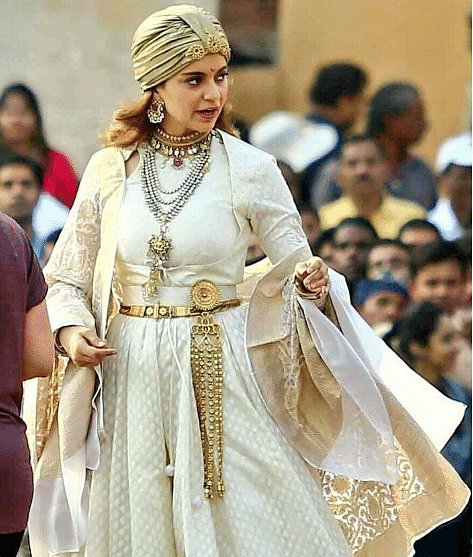
Even before its release, the film Manikarnika: The Queen of Jhansi, has managed to ruffle a few feathers and has come under attack from a Brahmin outfit in Rajasthan known as the Sarv Brahmin Mahasabha. The outfit is irked over the “historical tampering” and the celebrated Brahmin queen’s apparent “indecent portrayal”.
Suresh Mishra, President, Sarva Brahman Mahasabha, wrote a letter to the makers, saying the film's shooting will "not be allowed in Rajasthan till the complete information on the historical ground of the story is made available".
Rumours are rife that the makers have carved Lakshmibai’s character along the lines of Jaishree Misra’s novel Rani.
Misra, however, denies being approached by the makers,
If at all these film-makers have referred to my novel, they haven’t informed me of it yet.

Even Kangana Ranaut has denied any love story in the movie, saying, “This movie is sure to instil a feeling of pride among the people.”
Talking about the new trend of protests preceding the release of so called historical dramas, Dr Sandhya Sharma, Assistant Professor of History at Vivekananda College, University of Delhi says:
One cannot take a film as an authentic expression of history. History, anyway, is a construction. It is created through the mind of a historian and there will always be several interpretations and biases associated to it. A movie is a commercial project and is bound to have some figment of imagination or creative freedom at play.
Misra agrees, “As far as protests go, they are almost always politically motivated and never about genuine feelings of offence or grievance.”
The release date of Manikarnika: The Queen of Jhansi has not yet been announced.
Doctrine of Lapse and the Annexation of Jhansi
The British took advantage of Maharaja’s death in 1853, and the then Governor General, Lord Dalhousie applied the Doctrine of Lapse, rejecting Damodar Rao’s claim to the throne. This, despite Gangadhar Rao and Lakshmibai solemnising the adoption of Damodar Rao in the presence of a British political officer.
An adopted heir could only inherit the private property of the ruler. Neither was he entitled to the estate nor to a pension after the ruler’s death. Many states lost their sovereignty due to this doctrine and became British territories. Kittur, Satara, Jaipur, Sambhalpur, Udaipur, Nagpur were also annexed through Doctrine of Lapse in addition to Jhansi.
Irked by the unfairness of the British, Lakshmibai even pleaded her case in a court in London which regardless to say, turned her down.
The British annexed Jhansi, seized the state jewels, granted Lakshmibai a meagre annual pension and asked her to leave the fort forever. Left without an alternative, the Rani moved to what is now known as the Rani Mahal.
Recently a letter, apparently written by Rani Lakshmibai to Lord Dalhousie shortly before the war of 1857, was unearthed, as per a report published by BBC. The letter was “found in London in the archives of the British Library.” “In the letter, the Rani of Jhansi describes the fateful events on the night her husband died”, the report says.
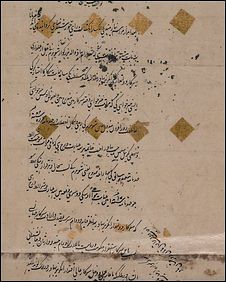
The Period Between 1854 and 1857
The period between the annexation of Jhansi and the breakout of the 1857 revolt piques curiosity. What was Rani Lakshmibai doing in the interim period?
London-based author Jaishree Misra who wrote Rani – one of the most comprehensive books on Lakshmibai – tells The Quint:
In those years, she wrote letters/khureetas, sent an emissary called Azimulla to the British Parliament, invited to her court an Australian lawyer called John Lang who had successfully sued the East India Company on behalf of an Agra banker to seek his legal counsel.
Misra further says that her research led her to believe that Rani Lakshmibai was in fact a pacifist and tried very hard to avoid war. But once embroiled in the battle, she gave it her all.
The Revolt of 1857
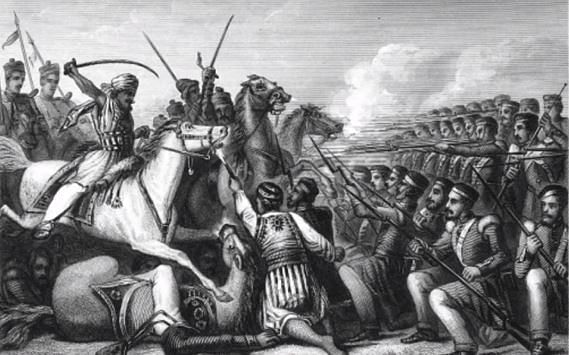
Often hailed as the first war of independence, the Sepoy mutiny of 1857 was the first organised and collective – political, military, socio-economic, religious – resistance against the oppressive British rule.
Historian RC Majumdar in his book, The Sepoy Mutiny and The Revolt of 1857, lists some of the many causes which led to the revolt of 1857:
- A ruin of trade and industry
- Unfair monopolies of trade items which extended to indispensable necessities of life
- Oppressive agrarian policy
- The Ryotwari system
- Repeated attempts by Christian missionaries to force conversion on Hindus
- Black Acts of 1849
- The evil, inaccessible and corrupt British administration – the unavailability of British officers to hear the pleas of Indians, language barrier, partiality of the British towards their own to name a few
- Non-admission of Indians into the legislative and administrative branches of the government
- Exclusion of natives from high appointments under the government
- Pride, arrogance, lack of cordiality towards Indians
Though a host of factors contributed to the mutiny, it was the greased cartridges introduced by the company that acted as the trigger to the mutiny. The new Enfield Rifle introduced by the Company required the sepoys to bite the cartridge by their teeth which was unacceptable to the soldiers as they were greased with animal fat (beef and pork). Enraged at the Britishers’s attempt to defile their religion, the soldiers joined hands in the collective mutiny.
They were joined by the rulers of the annexed states who were nursing the bitter pangs of expulsion from their own kingdoms – Rani Lakshmibai being one of them.
Rani Lakshmibai’s Participation in the Revolt
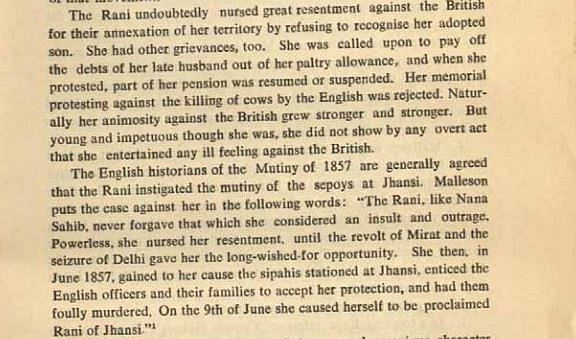
It is said that prior to the Sepoy Mutiny, Lakshmibai was rather reluctant to rebel against the British and that Jhansi was relatively peaceful in the initial phases of the revolt, unlike most of north India.
It was only in 1858 that she took up arms against the British when Sir Hugh Rose, commanding officer of the British forces, demanded the surrender of Jhansi.
Talking about the Jokhun Bagh massacre, Jaishree Misra says,
Rani Lakshmibai had actually given refuge to the local British contingent of about 70 men, women and children when reports of the uprising in other places started coming in. But she was coming under increasing pressure to get rid of them by her well-wishers and, recognising that she was compromising her own position, she finally asked them to go to the neighbouring kingdom of Datia. When this group was being escorted out, they were attacked in Jokhun Bagh, killing almost everyone – although a few people escaped and gave eyewitness accounts.
Rani wrote to the British authorities explaining the entire situation and also her helplessness and innocence in the massacre. British author Saul David seconds this explanation in his book The Indian Mutiny: 1857, when he says, “In true Maratha fashion, she would have been unwilling to enter the mutiny publicly unless success was guaranteed… for this reason, and for this reason alone she was probably not responsible for the massacre.” Historian RC Majumdar also holds similar views.
He says, “If the sepoys were really goaded into the mutiny by her she would immediately have been hailed as the ruler.”
Rani Lakshmibai was given the charge of Jhansi for a brief period following the massacre and before the arrival of another British superintendent. The Rani ruled Jhansi in the interim period, but only on behalf of the British government.
The Battle for Jhansi
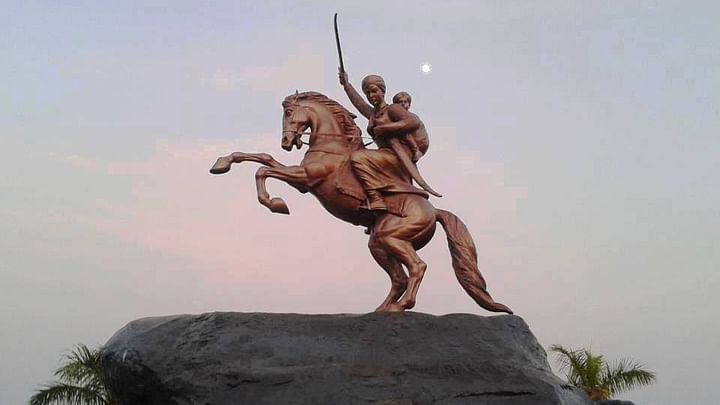
RC Majumdar makes some crucial inferences with regards to the events that led to the famous battle for Jhansi:
- Gradually the British changed their views about Lakshmibai and suspected her of complicity both with the mutiny of the sepoys and the massacre of the English at Jhansi.
- It was only when the Rani felt convinced that the British government held her responsible for the mutiny and the massacre, and that she would have to face a trial on this charge, that she decided to fight – preferring an honourable death in the battlefield than a hangman’s rope.
When Sir Hugh Rose demanded a complete surrender to the British rule, Lakshmibai rebelled and organised forces to oust the British. She was joined in the battle led by Tatya Tope and Nana Sahib.
She gave the British a tough fight, fled to Kalpi and then Gwalior during the course of the battle and finally succumbed to the British forces in Gwalior in 1858.
The descriptions we have all grown up with of her bravery and heroism are absolutely true. She marched into battle alongside her troops, dressed like a man, and died when a Hussar horseman’s sword came down on her head in the heat of battle. There is a graphic and heartbreaking eyewitness account of her falling from her horse with one eyeball emerging from its socket. It is said that her troops spirited her away into the forests, but General Hugh Rose who led the British forces against her claimed to have seen her cremation in a letter he later wrote to his commander praising her courage.Jaishree Misra, Author of Rani
Her body was cremated as per her wishes (some accounts note that Lakshmibai didn’t want her body to be captured by the British hence asked a hermit to cremate it). Three days after the death of Lakshmibai, the British captured the Fort of Gwalior.
Lakshmibai's tomb is situated in the Phool Bagh area of Gwalior.
Rani's Participation in Revolt of 1857: Patriotism or Quest for Power?
Much like the causes of the mutiny itself, the motives of Rani Lakshmibai’s participation in the 1857 uprising has been a matter of debate among historians and scholars. While some feel that she participated in the uprising to save her territory, other more nationalistic readings have ascribed her participation to patriotism.
The revolt of 1857 has been largely misunderstood as a war for nationalism. It did take that hue eventually, but at the heart of it 1857 was a quest for identity. Several protests for identity, authority, territory, regional identity, conquest for kingdom over the years have been clubbed under the name of patriotism. It is in this context that we need to establish or infer Rani Lakshmibai’s surge in the war.Sandhya Sharma, Assistant Professor of History at Vivekananda College, University of Delhi
RC Majumdar in his book The Sepoy Mutiny and the Revolt of 1857 argues that the uprising of 1857 was not a war of independence. He maintains that the revolt took different aspects in different regions.
Historians across generations and continents are divided over the revolt of 1857. Some call it mutiny while some nationalists such as VD Savarkar believe that it was the first war of Independence.
I believe that, initially, Rani Lakshmibai didn’t really want to fight the British with whom she had always maintained a certain cordiality. This is why she had extended help at first, giving the women and children of Jhansi cantonment refuge in her fort. However, after the Jokhun Bagh massacre, she was a marked woman and was pragmatic enough to recognise this fact. It was at this point that her development as a warrior began.Jaishree Misra, Author of Rani
Rani Lakshmibai in Literature
The historiography of the rebellion is vast and there are multiple, sometimes contrarian, views on the part played by Rani Lakshmibai in the mutiny.
DB Parasnis’ Marathi biography of Lakshmibai, A Biography of Queen Lakshmibai of Jhansi, published in 1894, claimed that she had taken charge of Jhansi not as a rebel, but to rule in the company’s name – a stark contrast to the readings of British historians.
Novelist Vrindavanlal Verma, in his 1946 novel Jhansi ki Rani, paints her in a Hindu reformist viewpoint, as a brave compassionate ruler – an understanding that has painted much of the discourse since.
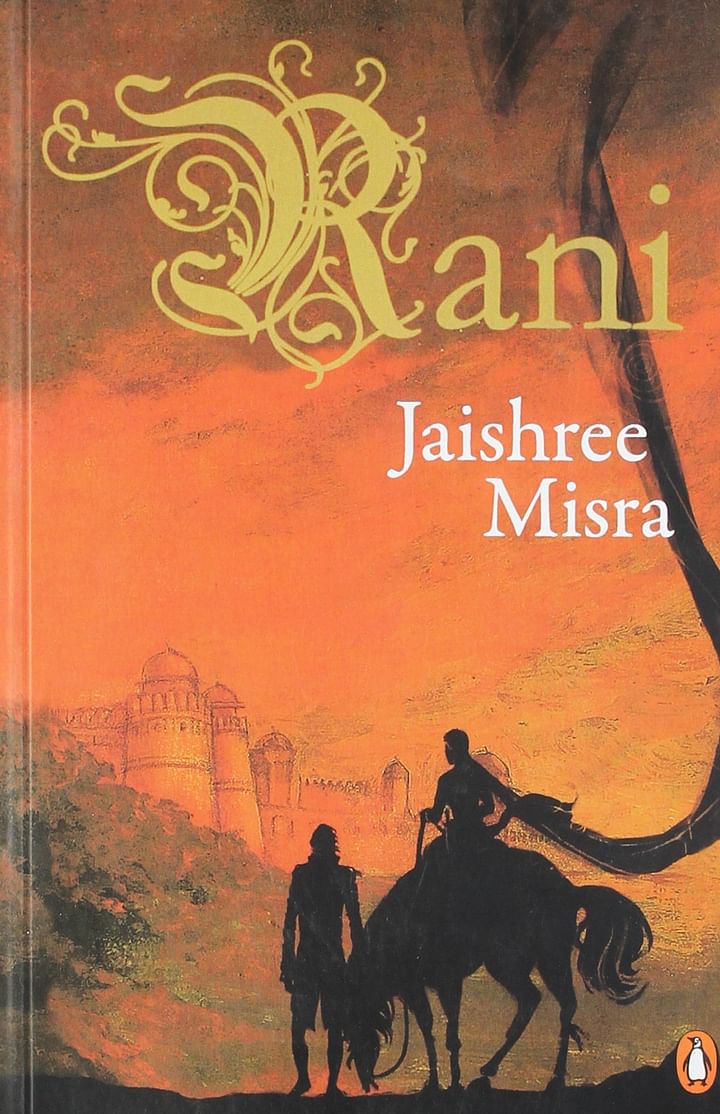
Jaishree Misra’s book Rani – which the author describes as half-fact, half-fiction – is perhaps one of the most controversial books on Lakshmibai’s life. The book was banned by the Mayawati-led Uttar Pradesh government at the time of its publication, calling a tale of romance between Lakshmibai and a British official, Robert Ellis, nothing short of blasphemy for the custodians of patriotism.
The author doesn’t camouflage Lakshmibai’s imperfections and vulnerabilities, attempting to project the celebrated queen as a flesh and blood character.
However, Misra vehemently denies the alleged love angle and says,
It’s hardly a romance. Or ‘affair’ as many publications have misreported. There are enough historical sources to establish beyond doubt that Major Ellis laid his career on the line to help the widowed Rani Lakshmibai. I have evidence in support of this.
She agrees that her book is a historical fiction, adding that historical records can never give us information on people's motivations or private thoughts anyway.
What I have tried to depict is Ellis’ admiration of the queen. In fact, Ellis decides to return to England when Lord Dalhousie orders him to stop assisting Rani Lakshmibai rather than compromise his position. Lakshmibai is aware of Ellis’s feelings, but maintains her own silence, conscious of her duty to her state, her people, her son, her father. I don’t know how this can be described as an ‘affair’.Jaishree Misra, Author of Rani
Rani Lakshmibai in Popular Culture
“Bundeley Harbolon se hamney suni kahani thi,
Khoob ladi mardani woh to Jhansi wali Rani thi”
These lines from Subhadra Kumari Chauhan’s iconic poem ‘Jhansi ki Rani’ seem to have inspired countless popular culture adaptations of Rani Lakshmibai. The poem is also taught to school kids across India as a tribute to the valour of the queen.
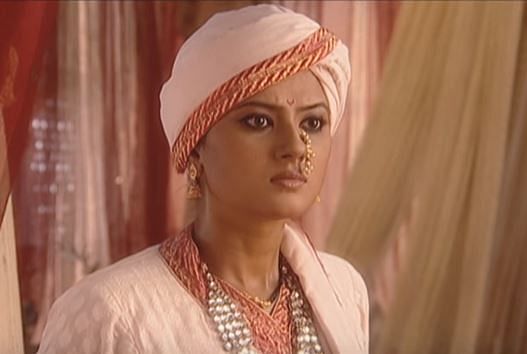
Sohrab Modi’s Jhansi Ki Rani (1953) remains among the earliest films made on Lakshmibai’s life and her role in the Sepoy mutiny. The film was also dubbed in English and released as The Tiger and the Flame. In 2009, Zee TV premiered a historical drama titled Ek Veer Stree Ki Kahaani... Jhansi Ki Rani on the life of Lakshmibai. The show was on air for almost two years with Ulka Gupta and Kratika Sengar playing the titular role.
Statues of Lakshmibai riding a horse are scattered all around the country. Lakshmibai National University of Physical Education in Gwalior, Maharani Laxmibai Medical College in Jhansi, and the Rani Jhansi Marine National Park are institutional tributes to the memory of the queen of Jhansi. Not just this, a women’s unit in the Indian National Army is named the ‘Rani of Jhansi Regiment’ to commemorate the warrior queen’s bravery.
Indian film actress Kangana Ranaut will now be seen playing Rani Lakshmibai in an upcoming Bollywood film titled Manikarnika: The Queen of Jhansi, with Ankita Lokhande stepping in the shoes of Jhalkaribai.
(At The Quint, we are answerable only to our audience. Play an active role in shaping our journalism by becoming a member. Because the truth is worth it.)
.jpg?rect=0%2C0%2C1280%2C720&auto=format%2Ccompress&fmt=webp&width=720)